Game Theory-Based Bi-Level Capacity Allocation Strategy for Multi-Agent Combined Power Generation Systems
Abstract
1. Introduction
2. Literature Review and Contributions
2.1. Literature Review
2.2. Contributions
- A scenario generation method combining Latin Hypercube Sampling (LHS) and the Kantorovich distance-based SBR algorithm is proposed to handle the uncertainty of wind–solar output. The SBR algorithm continuously filters scenarios to minimize the probability distance between the original and the retained scenario sets, thereby better reflecting the original probability distribution. This approach not only improves scheduling accuracy but also reduces cost increases caused by forecasting errors.
- A bi-level optimization model considering the interaction between capacity allocation and operation scheduling is developed, enabling dynamic parameter interaction between the two levels. The upper-level focuses on the capacity configuration of different generation entities to determine the optimal capacity mix, while the lower-level addresses multi-objective operation scheduling, balancing conflicting objectives such as “profitability–stability” under operational constraints. Through the deep integration of long-term and short-term decision-making, the model enhances system economy and energy utilization efficiency.
- A game theory-based multi-agent capacity optimization method is proposed, considering the diversity of energy forms and the complexity of interest relationships in a combined power generation system. Specifically, the operators of wind power, photovoltaic, pumped hydro storage, and thermal power subsystems are modeled as participants, with equipment capacity as the optimization strategy and net profit as the utility function. On this basis, a non-cooperative game model for multi-agent capacity allocation is established, the existence of a Nash equilibrium is proved, and the model is solved using an improved particle swarm optimization algorithm. Furthermore, considering the complementary characteristics of different energy forms, the feasibility of cooperative alliances is explored, and the Shapley value method is employed to address benefit allocation in the cooperation process, thereby ensuring both stability and fairness.
3. Models and Methods
3.1. Generation of Typical Wind and Photovoltaic Power Output Scenarios
3.1.1. Scenario Generation and Reduction
3.1.2. Indices for Determining the Number of Typical Scenarios
3.2. Game Theory-Based Capacity Configuration Method for Multi-Agent Combined Power Generation Systems
- (1)
- Participants
- (2)
- Strategy Set
- (3)
- Utility Function
3.2.1. Non-Cooperative Game and Nash Equilibrium
- (1)
- Nash Equilibrium
- (2)
- Equilibrium Conditions and Existence
- (1)
- For each participant, , when the strategies, , of other participants are determined, is its optimal strategy.
- (2)
- For each participant, , there is no incentive to unilaterally change their own strategy, .
3.2.2. Cooperative Game and Shapley Value Allocation Method
- (1)
- Basic Characteristics of Cooperative Game
- (2)
- Shapley Value Allocation Method
3.3. Objective Function of the Upper-Level Capacity Planning Model
- (1)
- Objective Function of Non-Cooperative Game Model
- (2)
- Objective Function of Cooperative Game Model
- (3)
- Constraints of the Upper-Level Capacity Planning Model
3.4. Objective Function of the Lower-Level Optimal Scheduling Model
- (1)
- Objective Function of Non-Cooperative Game
- (2)
- Objective Function of Cooperative Game
- (3)
- Constraints of the Lower-Level Optimal Scheduling Model
- a.
- Power Flow ConstraintsIn the formula, and are the active power and reactive power of node (units: kW, kVar), respectively, reflecting the power injection situation of the node; and are the voltage amplitudes of nodes and (unit: kV), and their value range is usually 0.9–1.1 p.u. (per unit value) to ensure the safe and stable operation of the power grid; and are the conductance and susceptance between nodes and (unit: S), respectively, characterizing the conductivity and energy storage characteristics of the line; is the voltage phase angle between nodes and (unit: rad), reflecting the phase difference between nodes. Its value is usually small (generally in the range of −0.5–0.5 rad), and an excessively large value may lead to line overload.
- b.
- Output Power Balance ConstraintsIn the formula, and , respectively, represent the actual output of wind power and photovoltaic power at time under scenario (unit: kW); and , respectively, represent the generating power and pumping power of the pumped-storage power station at time (unit: kW, where a negative value of the pumping power indicates electric energy consumption); is the active power transmitted from thermal power to the power grid at time (unit: kW); represents the total load of the power grid at time under scenario (unit: kW); and represents the total amount of curtailed wind and photovoltaic power at time under scenario (unit: kW).
- c.
- Power Acceptance Constraints of the Power GridIn the formula, and , respectively, represent the minimum and maximum active power that the power grid is allowed to accept (unit: kW).
- d.
- Energy Balance of the Upper ReservoirIn the formula, and are the energies stored in the upper reservoir of the pumped-storage power station at times and , respectively (unit: kWh); and are the generating power and pumping power of the pumped-storage power station at time , respectively (unit: kW); and are the power generation efficiency and pumping efficiency of the pumped-storage power station, respectively, usually taking values between 0.75 and 0.85, reflecting losses during the energy conversion process.
- e.
- Pump Constraints of Pumped-Storage Power StationIn the formula, and are the generating power and pumping power of the pumped-storage power station at time , respectively (unit: kW); represents the effective energy stored in the upper reservoir after the pumping power at time t is converted by the pumping efficiency; represents the energy consumed from the reservoir at time . represents the upper limit of the pumping power of the pumped-storage power station at time . Formula (15) is used to ensure that the energy storage and release process of the pumped-storage power station conforms to actual physical laws.
- f.
- Wind and PV Curtailment ConstraintsIn the formula, is the wind curtailment power at time (unit: kW); is the actual wind power injected into the grid at time (unit: kW); and is the theoretical maximum exploitable wind power at time (unit: kW). The relationship between the three reflects the wind power consumption situation. Similarly, , , and are, respectively, the photovoltaic curtailment power, the photovoltaic power injected into the grid, and the theoretical maximum exploitable photovoltaic power at time (unit: kW).
- g.
- Constraints of Thermal Power UnitsThe output constraints of thermal power units are as follows:In the formula, and are, respectively, the lower and upper limits of the maximum output of the thermal power unit (unit: kW).
- h.
- The ramp constraints of thermal power units are as follows:In the formula, is the maximum output power ramp-up rate of the thermal power unit, representing the maximum value by which the output power of the thermal power unit can increase within a unit time; is the maximum output power ramp-down rate, representing the maximum value by which the output power of the thermal power unit can decrease within a unit time (unit: kW/h).
3.5. Model Solution
| Algorithm 1: The pseudo-code of bi-level particle swarm optimization algorithm. |
|
4. Case Analysis
5. Results Analysis
5.1. Results of Wind and PV Output Uncertainty
5.1.1. Results of Wind and Photovoltaic Power Output Scenarios Generation
5.1.2. Performance Analysis of Scenario Reduction
5.1.3. Sensitivity Analysis of the Number of Typical Scenarios
5.1.4. Verification of the Superiority of Scenario Reduction
5.2. Analysis of Capacity Configuration Results for Multi-Agent Combined Power Generation Systems Under Non-Cooperative Game
- (1)
- Sensitivity Analysis of Each Participant’s Utility Function and Installed Capacity
- (2)
- Results Analysis under Non-Cooperative Game Mode
5.3. Analysis of Capacity Configuration Results for Multi-Agent Combined Power Generation Systems Under Cooperative Game
5.4. Comparative Analysis of Optimization Results Between Non-Cooperative and Cooperative Games
5.5. Sensitivity Analysis
5.6. Performance Comparison of the Proposed and Traditional Bi-Level Optimization Models
6. Conclusions and Prospects
6.1. Conclusions
- Independent power supply from wind, photovoltaic, or pumped-storage hydropower stations alone is not economically viable. The penalty for insufficient system power supply is the main factor restricting the standalone generation of wind and photovoltaic power. Under non-cooperative games, the benefits of pumped-storage hydropower stations are far less than those of other power supply subsystems in the system, mainly because the contribution of pumped-storage hydropower stations to system stability is ignored in non-cooperative game modes.
- By comparing the results of 15 different alliances under the cooperative game mode, it is found that the wind–solar–thermal alliance outperforms the wind–solar–storage alliance. Photovoltaic power stations rely more on the regulation capacity of energy storage than wind power stations. The joint grid connection of wind and photovoltaic power helps reduce system voltage deviation and enhance power supply stability. The introduction of pumped-storage hydropower stations reduces the system’s dependence on thermal power generation, significantly reduces pollution emissions, and improves stability. The participation of pumped-storage hydropower stations enhances the efficient utilization of renewable energy and the economic benefits of the system. When the alliance consists of {wind power, photovoltaic, pumped-storage hydropower, thermal power}, the system achieves the highest power supply stability, the lowest carbon emissions (30,195.29 t), and the highest renewable energy utilization rate, with a renewable energy to pumped-storage capacity ratio of 12.875:1 and a renewable energy penetration rate of 53.93%. When this ratio exceeds 12.875:1, further increasing the installed capacity of renewable energy will lead to reduced system benefits and wasted renewable energy.
- Comparing the cooperative and non-cooperative game modes in the combined power generation system, the benefits per unit capacity of wind power, photovoltaic power, pumped-storage hydropower stations, and thermal power under the cooperative game mode are CNY 0.111 million/kW, CNY 0.018 million/kW, CNY 1.161 million/kW, and CNY 0.047 million/kW higher than those under the non-cooperative game mode, respectively. Additionally, the renewable energy utilization rate increases by 4.33%. In terms of pollutant emissions, CO2 emissions decrease by 5505.95 tons, SO2 emissions by 0.82 tons, and CO emissions by 3.98 tons. In terms of system stability, the total system voltage deviation is reduced by 5.51.
6.2. Prospect
- In the current model, the site selection of renewable energy is mostly based on the macro-zoning of resource endowments and does not elaborate on the micro-level transient weather characteristics—such as the impact of local strong winds and heavy rains on site selection. Meanwhile, since the research focuses on the collaborative optimization of the energy supply side, it has not yet involved surveys on the acceptance of end-users toward receiving facilities such as substations and transmission lines. Future research can introduce refined weather datasets and establish a correlation model between weather risks and site selection costs.
- This study addresses the uncertainty of wind power and photovoltaic power using measured historical data on wind speed and solar irradiance, but the data used does not incorporate the uncertainty in wind power generation that may be caused by wind turbine wake effects. Future research can introduce a wake effect model, integrate measured and simulated data, and consider the impact of wakes on the uncertainty of wind power generation in the planning and operation of joint operation systems. This will provide better guidance for the rational planning and grid-connected operation of renewable energy.
Author Contributions
Funding
Data Availability Statement
Conflicts of Interest
Abbreviations
| PV | Photovoltaic |
| WT | Wind turbine |
| PSH | Pumped hydro storage |
| TPS | Thermal power station |
| LHS | Latin Hypercube Sampling |
| SBR | Scenario-Based Reduction |
| SOC | State of Charge |
Appendix A
- (1)
- Take the wind power system as an example:
- (2)
- Thermal power system:
References
- Li, X.L.; Zhu, X.N.; Li, X.G.; Zhao, X.T.; Wei, G.L.; Gao, W.H.; Nie, C.C.; Yan, S.; Ge, L.H.; Wang, Z.Y. Recent advances in the extraction of critical metals from spent lithium-ion batteries: Challenges and solutions—A review. Sep. Purif. Technol. 2025, 376, 134070. [Google Scholar] [CrossRef]
- Cui, R.Y.; Hultman, N.; Cui, D.; McJeon, H.; Yu, S.; Edwards, M.R.; Sen, A.; Song, K.; Bowman, C.; Clarke, L.; et al. A plant-by-plant strategy for high-ambition coal power phaseout in China. Nat. Commun. 2021, 12, 1468. [Google Scholar] [CrossRef]
- Li, C.; Shah, N.; Li, Z.; Liu, P. Modelling of wind and solar power output uncertainty in power systems based on historical data: A characterisation through deterministic parameters. J. Clean. Prod. 2024, 484, 144233. [Google Scholar] [CrossRef]
- Javed, M.S.; Ma, T.; Jurasz, J.; Amin, M.Y. Solar and wind power generation systems with pumped hydro storage: Review and future perspectives. Renew. Energy 2020, 148, 176–192. [Google Scholar] [CrossRef]
- Liu, J.; He, D. Profit Allocation of Hybrid Power System Planning in Energy Internet: A Cooperative Game Study. Sustainability 2018, 10, 388. [Google Scholar] [CrossRef]
- Fu, H.; Shi, M.; Feng, M. Capacity optimization strategy for energy storage system to ensure power supply. Int. J. Low Carbon Technol. 2023, 18, 622–627. [Google Scholar] [CrossRef]
- Li, J.; Zhang, Z.; Shen, B.; Gao, Z.; Ma, D.; Yue, P.; Pan, J. The capacity allocation method of photovoltaic and energy storage hybrid system considering the whole life cycle. J. Clean. Prod. 2020, 275, 122902. [Google Scholar] [CrossRef]
- Xue, Y.; Zhang, C.; Jiang, F.; Dou, W.; Zhang, H.; Yang, C. Optimal capacity allocation method of integrated energy system considering renewable energy uncertainty. Front. Energy Res. 2022, 10, 1016756. [Google Scholar] [CrossRef]
- Yang, H.; Yu, Q.; Liu, J.; Jia, Y.; Yang, G.; Ackom, E.; Dong, Z.Y. Optimal Wind-Solar Capacity Allocation With Coordination of Dynamic Regulation of Hydropower and Energy Intensive Controllable Load. IEEE Access 2020, 8, 110129–110139. [Google Scholar] [CrossRef]
- Chen, L.; Wang, C.; Wu, Z. Reinforcement Learning-Based Time of Use Pricing Design Toward Distributed Energy Integration in Low Carbon Power System. IEEE Trans. Netw. Sci. Eng. 2025, 12, 997–1010. [Google Scholar] [CrossRef]
- Chen, Z.; Wu, Z.; Wei, L.; Yang, L.; Yuan, B.; Zhou, M. Understanding the synergy of energy storage and renewables in decarbonization via random forest-based explainable AI. Appl. Energy 2025, 390, 125891. [Google Scholar] [CrossRef]
- Si, Y.; Chen, L.; Zhang, X.; Chen, X.; Mei, S. Capacity Allocation of Hybrid Power System with Hot Dry Rock Geothermal Energy, Thermal Storage, and PV Based on Game Approaches. J. Mod. Power Syst. Clean. Energy 2023, 11, 290–301. [Google Scholar] [CrossRef]
- Zenginis, I.; Vardakas, J.S.; Echave, C.; Morató, M.; Abadal, J.; Verikoukis, C.V. Cooperation in microgrids through power exchange: An optimal sizing and operation approach. Appl. Energy 2017, 203, 972–981. [Google Scholar] [CrossRef]
- Chen, C.; Liu, C.; Ma, L.; Chen, T.; Wei, Y.; Qiu, W.; Lin, Z.; Li, Z. Cooperative-game-based joint planning and cost allocation for multiple park-level integrated energy systems with shared energy storage. J. Energy Storage 2023, 73, 108861. [Google Scholar] [CrossRef]
- Xie, J.; Zhang, L.; Chen, X.; Zhan, Y.; Zhou, L. Incremental Benefit Allocation for Joint Operation of Multi-Stakeholder Wind-PV-Hydro Complementary Generation System With Cascade Hydro-Power: An Aumann-Shapley Value Method. IEEE Access 2020, 8, 68668–68681. [Google Scholar] [CrossRef]
- Wang, H.; Zhang, C.; Li, K.; Ma, X. Game theory-based multi-agent capacity optimization for integrated energy systems with compressed air energy storage. Energy 2021, 221, 119777. [Google Scholar] [CrossRef]
- Li, Y.; Ling, F.; Qiao, X.; Zhong, J.; Zhao, X.; Li, C.; Liu, J.; Xing, X.; Yang, K.; Lan, W. Mixed Game-Based Two-Stage Planning of PV and Energy Storage in Distribution System with Multiple Integrated Energy Microgrids. IEEE Trans. Ind. Appl. 2024, 60, 8054–8066. [Google Scholar] [CrossRef]
- Dai, B.; Wang, H.; Li, B.; Li, C.; Tan, Z. Capacity model and optimal scheduling strategy of multi-microgrid based on shared energy storage. Energy 2024, 306, 132472. [Google Scholar] [CrossRef]
- Wu, W.; Li, Y.; Wang, S.; Wang, Z.; Zhou, S.; Zhang, Y.; Zheng, M. Coordinated Planning for Multiarea Wind-Solar-Energy Storage Systems That Considers Multiple Uncertainties. Energies 2024, 17, 5242. [Google Scholar] [CrossRef]
- Zheng, F.; Meng, X.; Wang, L.; Zhang, N. Operation Optimization Method of Distribution Network with Wind Turbine and Photovoltaic Considering Clustering and Energy Storage. Sustainability 2023, 15, 2184. [Google Scholar] [CrossRef]
- Ali, A.; Abbas, G.; Keerio, M.U.; Touti, E.; Ahmed, Z.; Alsalman, O.; Kim, Y.S. A Bi-Level Techno-Economic Optimal Reactive Power Dispatch Considering Wind and Solar Power Integration. IEEE Access 2023, 11, 62799–62819. [Google Scholar] [CrossRef]
- Xie, J.; Duan, J. Firm generation capacity allocation strategy of wind-solar-hydro complementary generation system based on cooperative game. Autom. Electr. Power Syst. 2023, 47, 79–88. (In Chinese) [Google Scholar]
- Xu, B.; Zhu, F.; Zhong, P.; Chen, J.; Liu, W.; Ma, Y.; Guo, L.; Deng, X. Identifying long-term effects of using hydropower to complement wind power uncertainty through stochastic programming. Appl. Energy 2019, 253, 113535. [Google Scholar] [CrossRef]
- Khan, N.A.; Awan, A.B.; Mahmood, A.; Razzaq, S.; Zafar, A.; Sidhu, G.A.S. Combined emission economic dispatch of power system including solar photo voltaic generation. Energy Convers. Manag. 2015, 92, 82–91. [Google Scholar] [CrossRef]
- Li, Q.; Zhang, Y.; Cheng, F.; Yao, L.; Xu, Y.; Liang, S.; Liu, W.; Li, Z. Generation expansion planning for Guizhou province based on the complementary characteristics of wind and solar. Energy Rep. 2022, 8, 574–584. [Google Scholar] [CrossRef]
- Zang, P.; Sun, G.; Zhao, Y.; Luo, Y.; Yuan, X. Stochastic optimization based on a novel scenario generation method for midstream and downstream petrochemical supply chain. Chin. J. Chem. Eng. 2020, 28, 815–823. [Google Scholar] [CrossRef]
- Kumar, L.; Khedlekar, U.K. Stochastic optimization of thermal energy storage for multi-energy systems with hydrogen and renewable integration: A scenario-based cost minimization model for dispatch, emissions, and cross-sector energy utilization. J. Energy Storage 2025, 132, 117830. [Google Scholar] [CrossRef]
- Liu, Y.; Nair, N.K.C. A Two-Stage Stochastic Dynamic Economic Dispatch Model Considering Wind Uncertainty. IEEE Trans. Sustain. Energy 2016, 7, 819–829. [Google Scholar] [CrossRef]
- Kim, M.; Park, T.; Jeong, J.; Kim, H. Stochastic optimization of home energy management system using clustered quantile scenario reduction. Appl. Energy 2023, 349, 121555. [Google Scholar] [CrossRef]
- Zhou, R.; Chen, S.; Han, Y.; Liu, Q.; Chen, Z.; Hu, W. Probabilistic spatiotemporal scenario generation method for dynamic optimal power flow in distribution networks. Int. J. Electr. Power Energy Syst. 2024, 155, 109667. [Google Scholar] [CrossRef]
- Xie, Y.; Huo, Z.; Wu, C.; Yao, W.; Wang, J.; Qiao, Y. Improved Backward Scenario Reduction Method for Generation Planning Considering Extreme Scenarios. In Proceedings of the IEEE 7th Conference on Energy Internet and Energy System Integration (EI2), Hangzhou, China, 15–18 December 2023; pp. 499–504. [Google Scholar] [CrossRef]
- Khan, I.K.; Daud, H.B.; Zainuddin, N.B.; Sokkalingam, R.; Naheed, N.; Janisar, A.A.; Inayat, A.; Rana, M.S. Standardization of expected value in gap statistic using Gaussian distribution for optimal number of clusters selection in K-means. Egypt. Inform. J. 2025, 30, 100701. [Google Scholar] [CrossRef]
- Bai, B.; Han, M.; Lin, J.; Sun, W. Scenario reduction method of renewable energy including wind power and photovoltaic. Power Syst. Prot. Control 2021, 15, 141–149. (In Chinese) [Google Scholar]
- Chen, X.; Dai, P.; Zhong, H.; Li, X.; Li, W. Photovoltaic typical output scenario clustering method considering comprehensive similarity measurement. Proc. CSEE 2024, 21, 8462–8474. (In Chinese) [Google Scholar]
- Myerson, R.B. John Nash’s Contribution to Economics. Games Econ. Behav. 1996, 14, 287–295. [Google Scholar] [CrossRef]
- Kang, K.; Zhang, Y.; Cheng, S.; Lu, X.; Tu, Z. Sensitivity analysis of renewable energy coupled hydrogen system to government reward and punishment policies based on multi-agent Nash equilibrium. Int. J. Hydrogen Energy 2025, 145, 862–881. [Google Scholar] [CrossRef]
- Yang, D.; Zhang, R.; Liu, C.; Bian, G. The Study of Long-Term Trading Revenue Distribution Models in Wind-Photovoltaic-Thermal Complementary Systems Based on the Improved Shapley Value Method. Energy Eng. 2025, 122, 2673–2694. [Google Scholar] [CrossRef]
- Baran, M.E.; Wu, F.F. Network reconfiguration in distribution systems for loss reduction and load balancing. IEEE Trans. Power Deliv. 1989, 4, 1401–1407. [Google Scholar] [CrossRef]
- Lin, C.H.; Chen, S.J.; Kuo, C.L.; Chen, J.L. Non-Cooperative Game Model Applied to an Advanced Metering Infrastructure for Non-Technical Loss Screening in Micro-Distribution Systems. IEEE Trans. Smart Grid 2014, 5, 2468–2469. [Google Scholar] [CrossRef]
- Feng, L.; Zhang, Y.; Wei, X.; Wang, M.; Niu, Z.; Wang, C. Interpretable prediction of coagulant dosage in drinking water treatment plant based on automated machine learning and SHAP method. J. Water Process Eng. 2025, 75, 107925. [Google Scholar] [CrossRef]
- Chouikhi, S.; Merghem-Boulahia, L.; Esseghir, M.; Snoussi, H. A Game-Theoretic Multi-Level Energy Demand Management for Smart Buildings. IEEE Trans. Smart Grid 2019, 10, 6768–6781. [Google Scholar] [CrossRef]
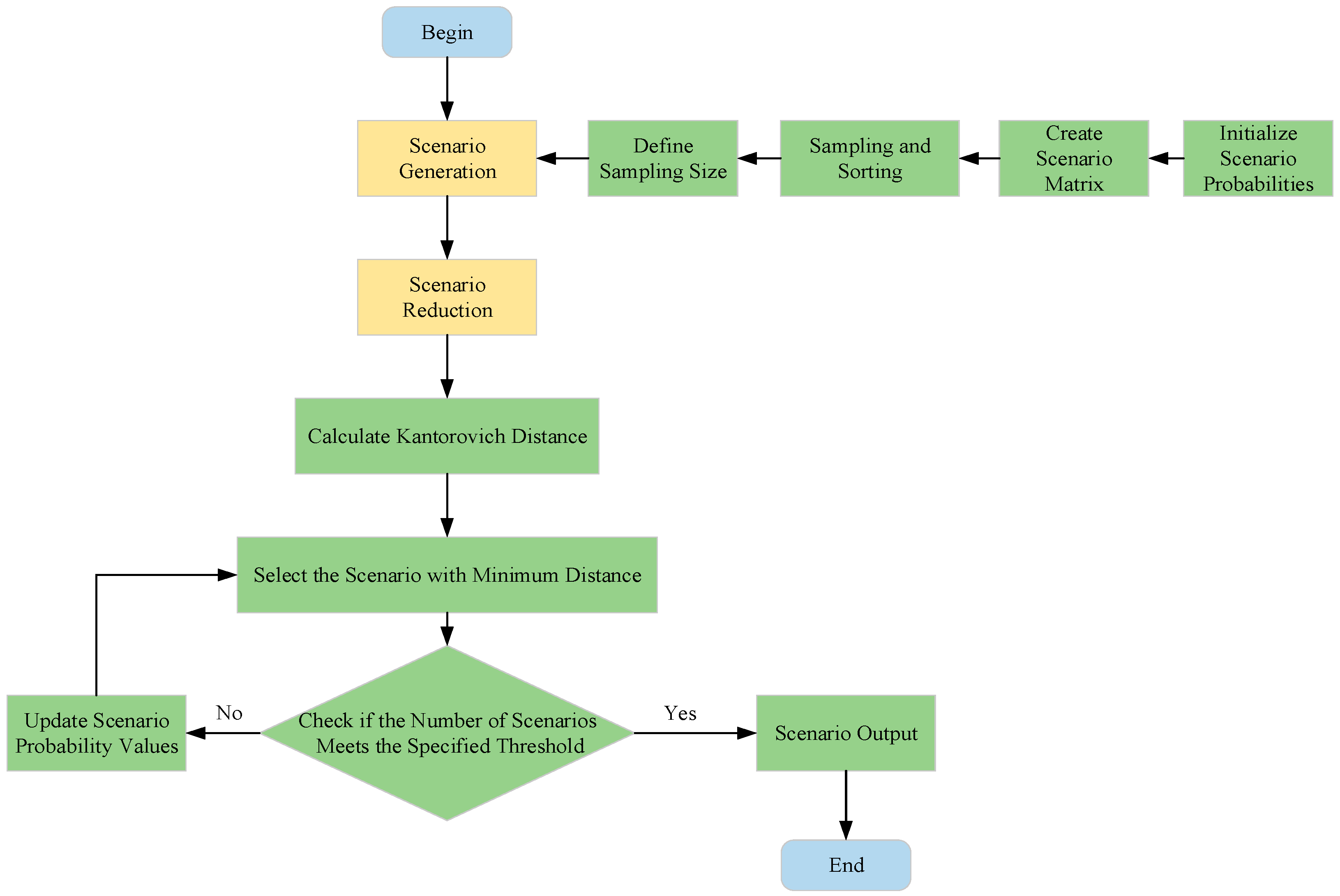
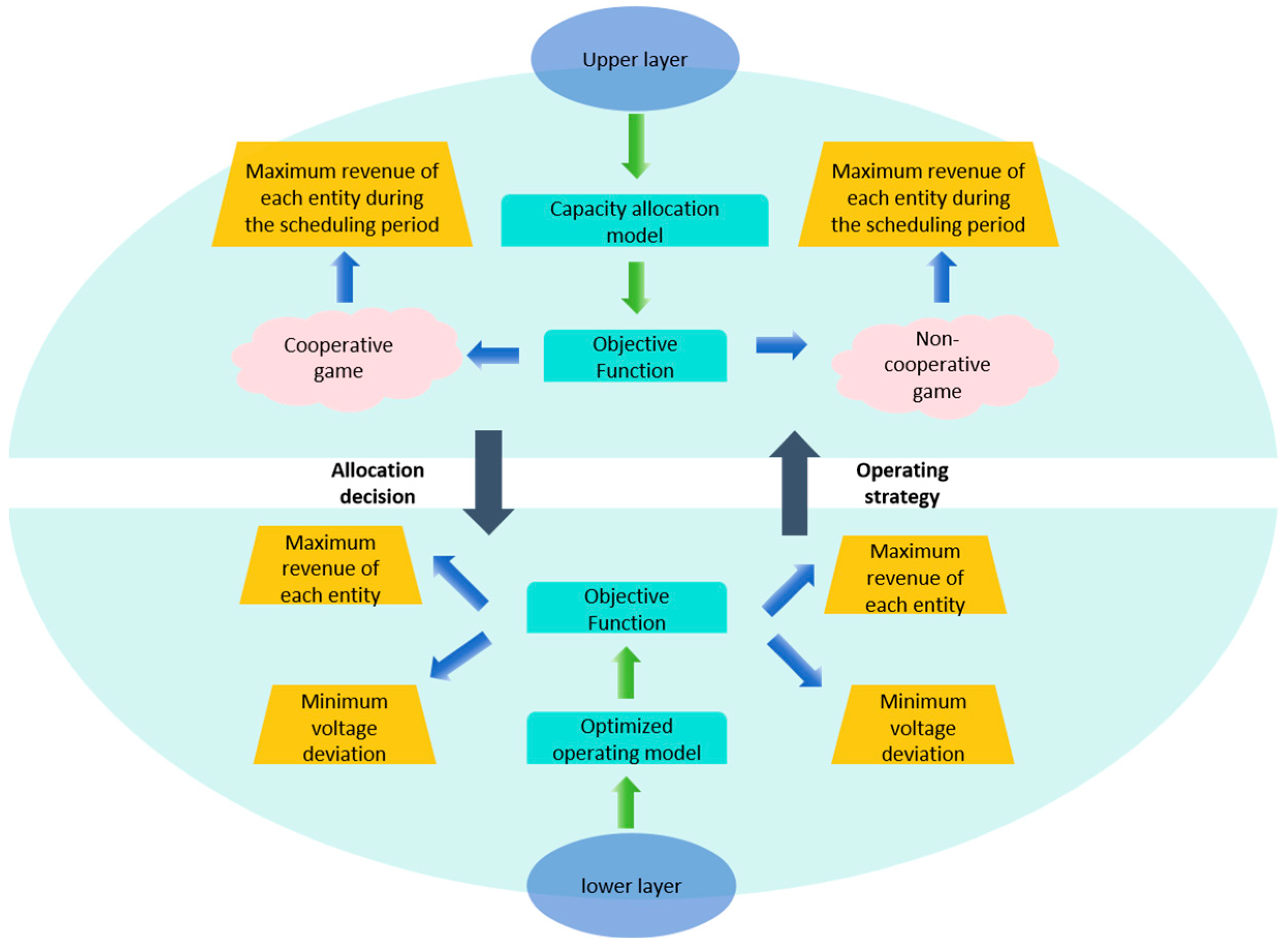
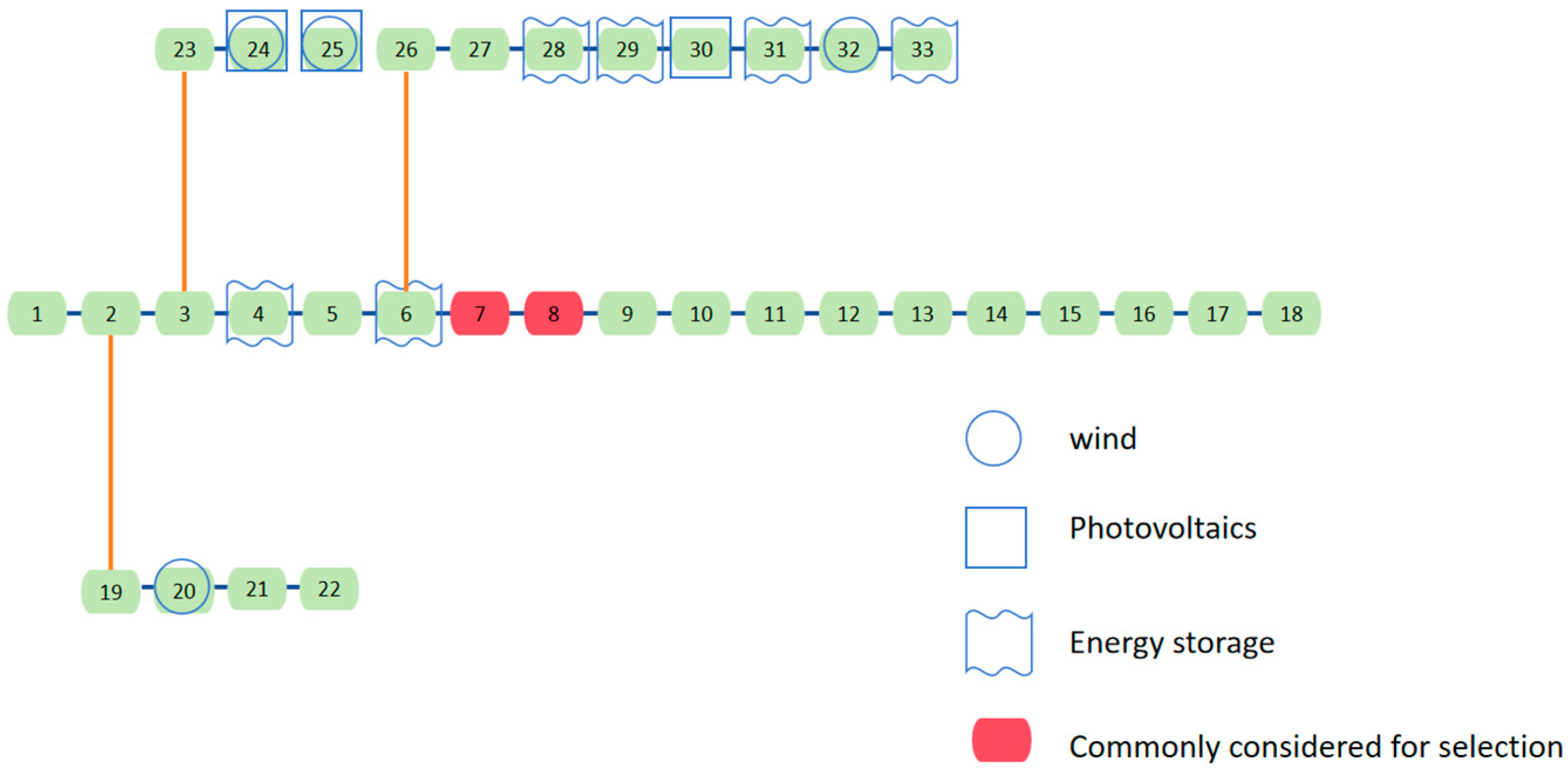
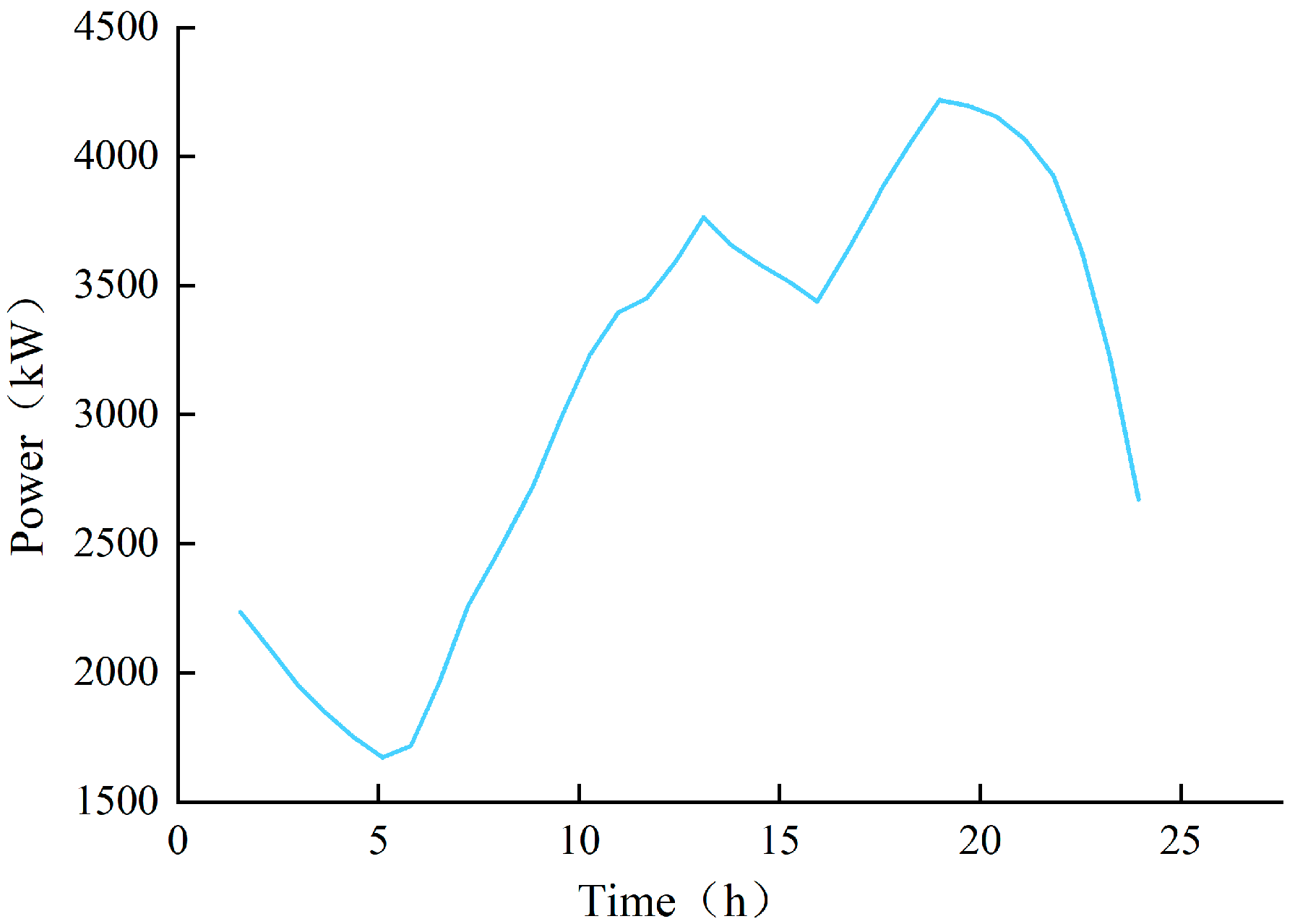

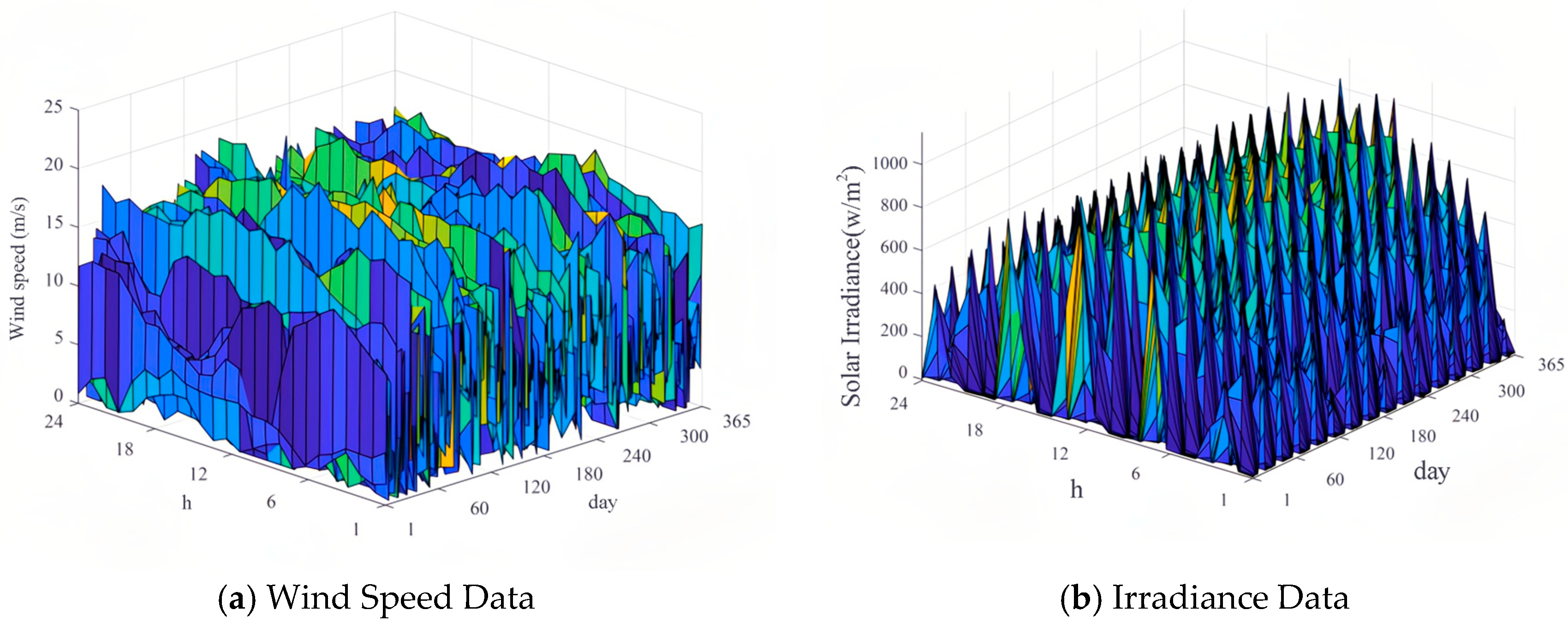
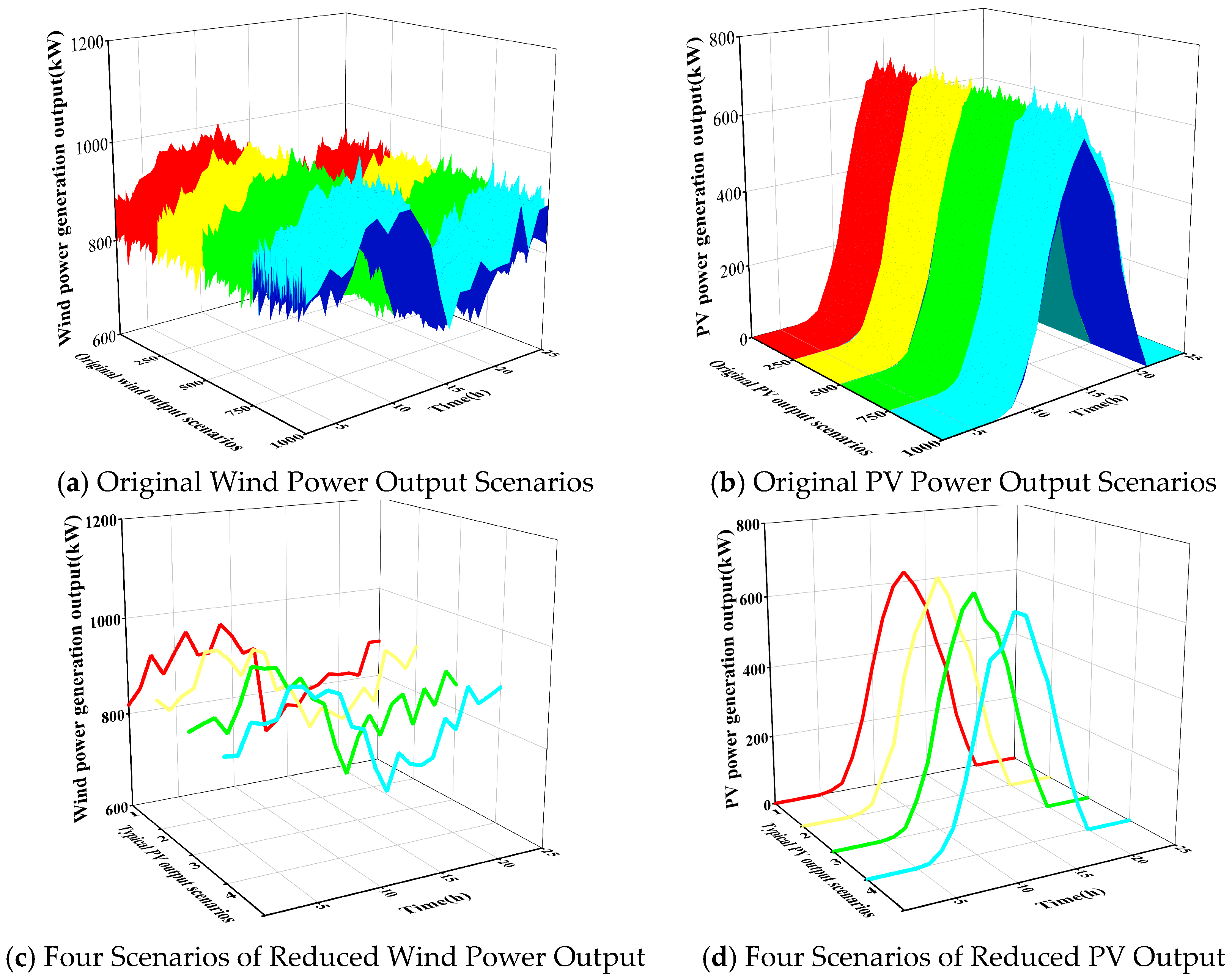
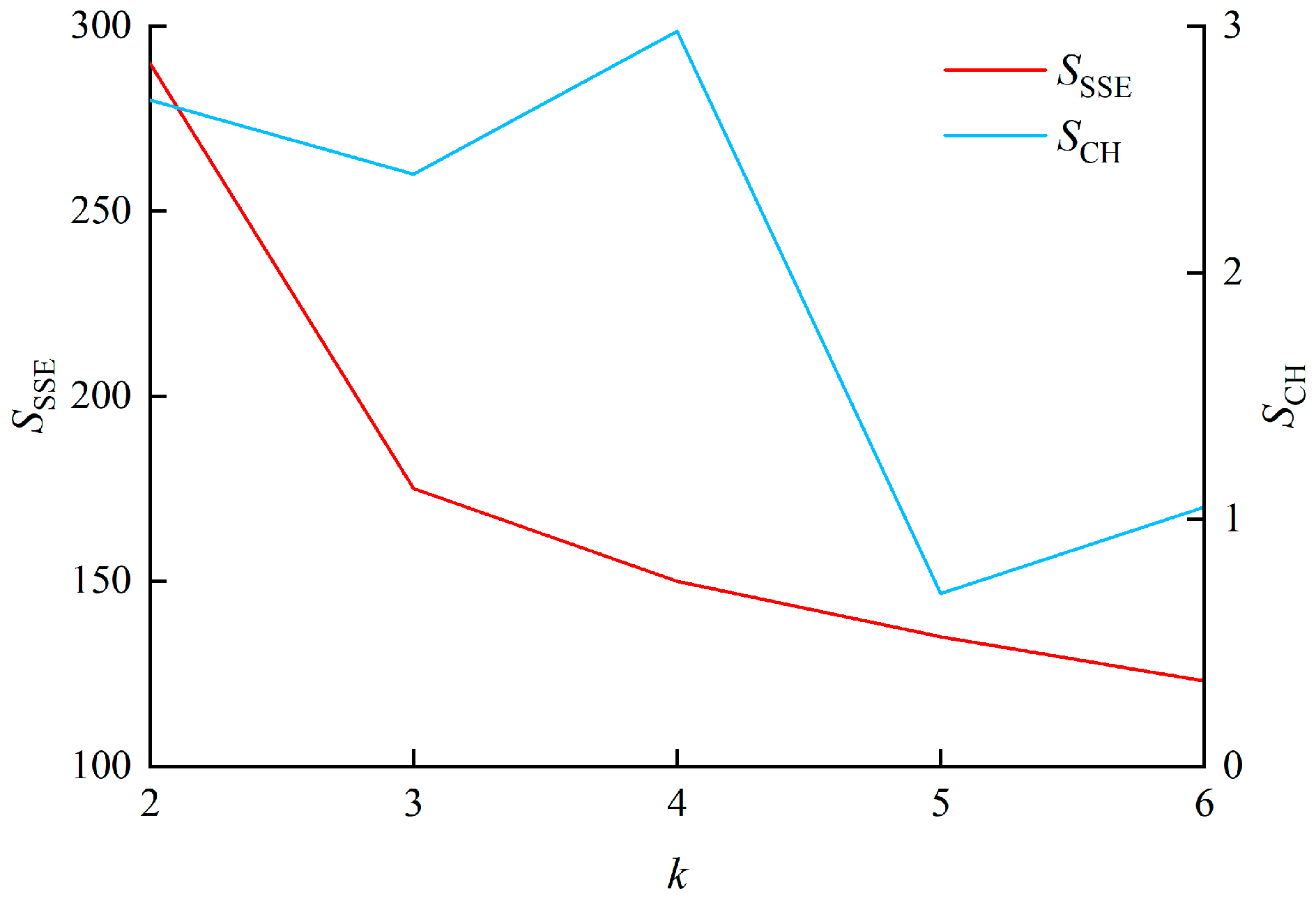
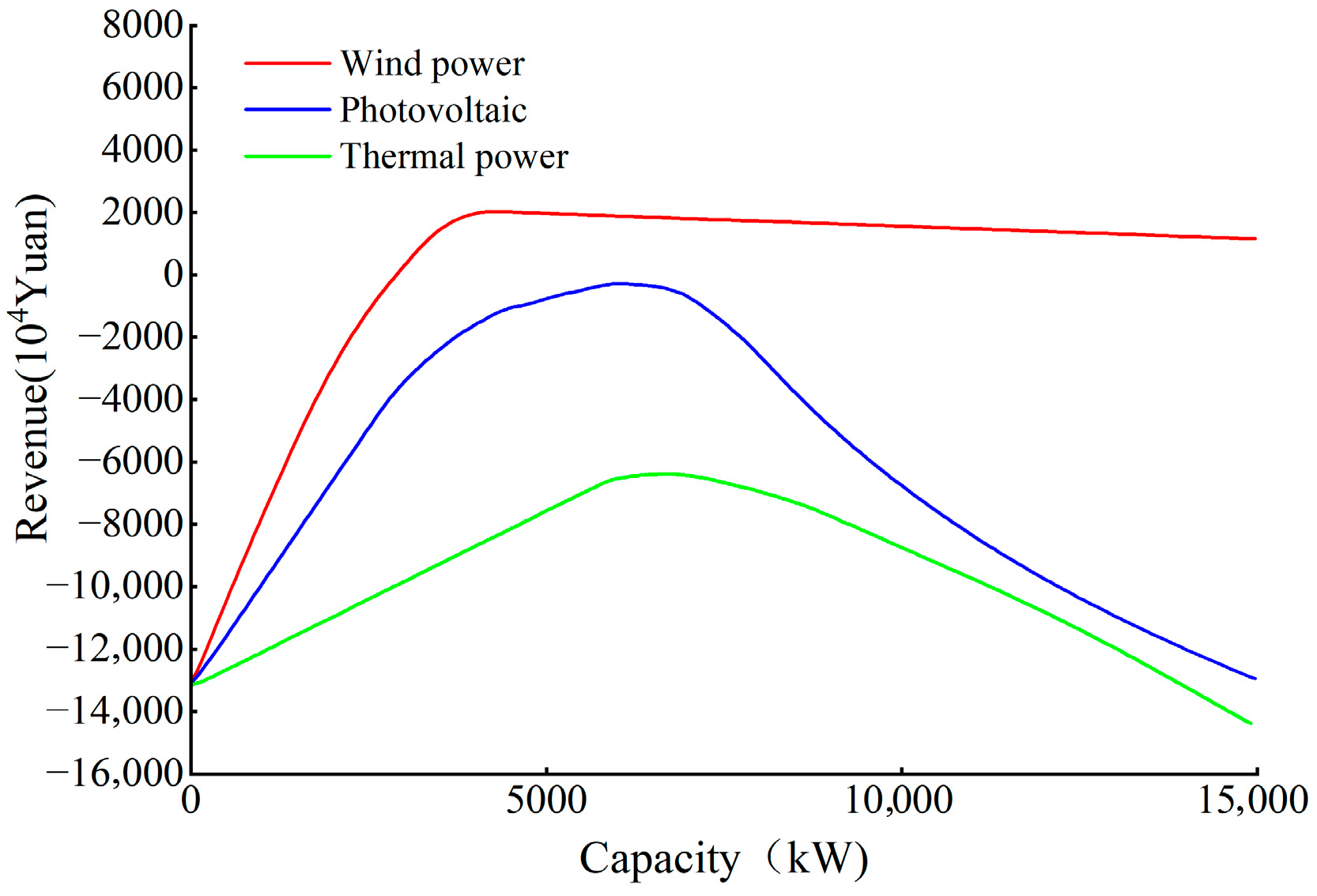
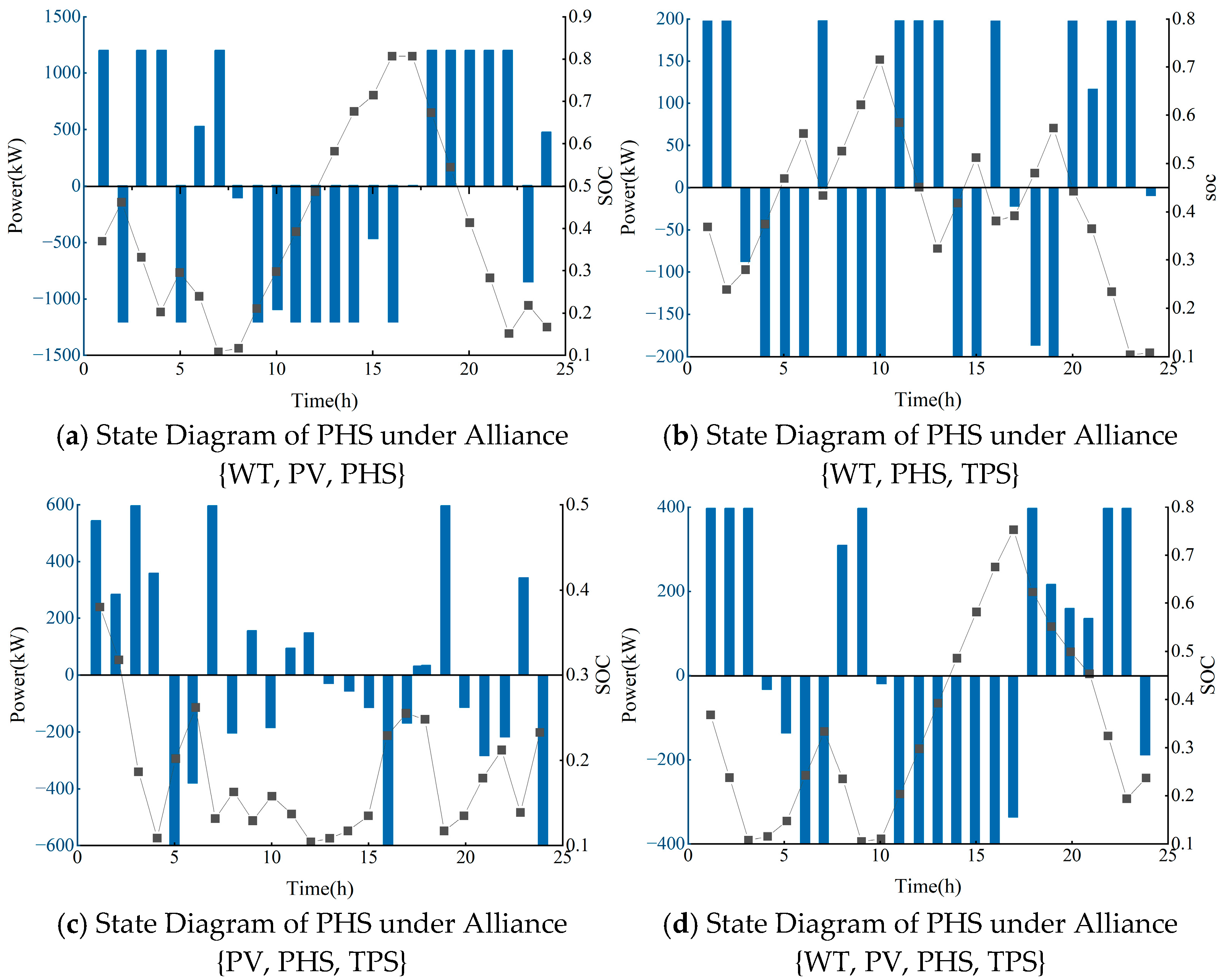
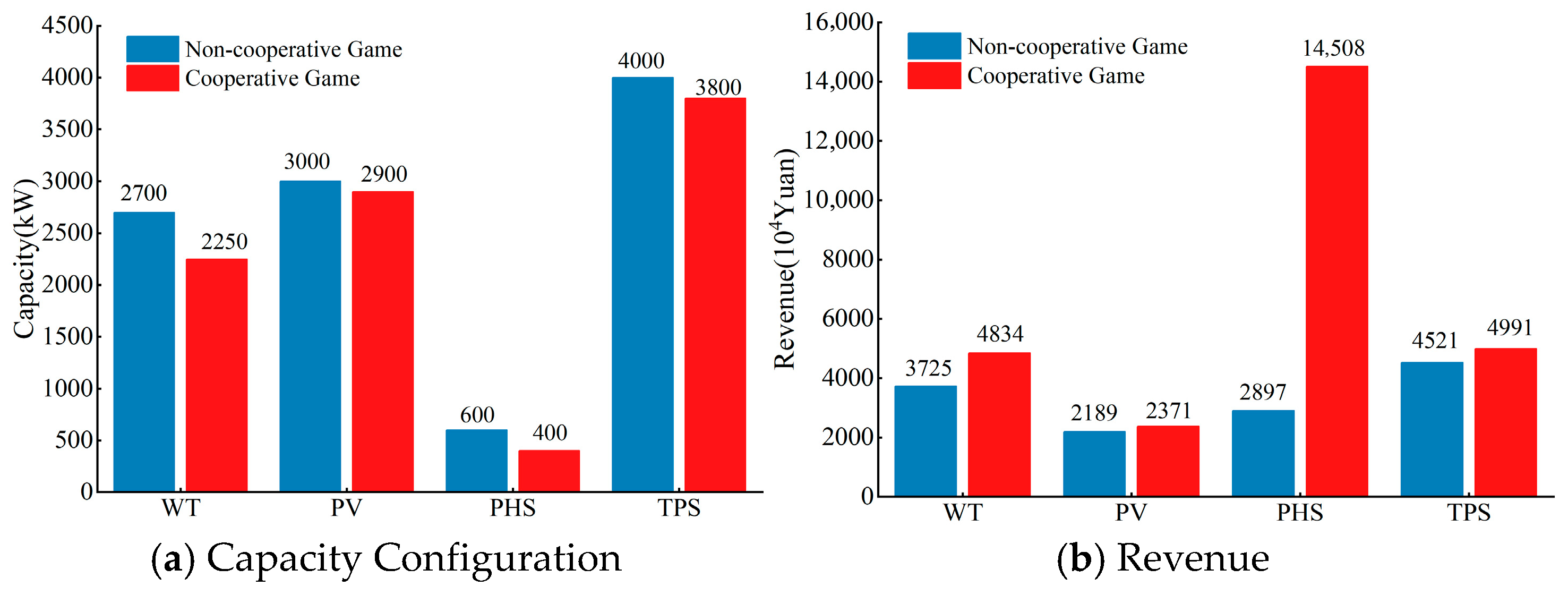


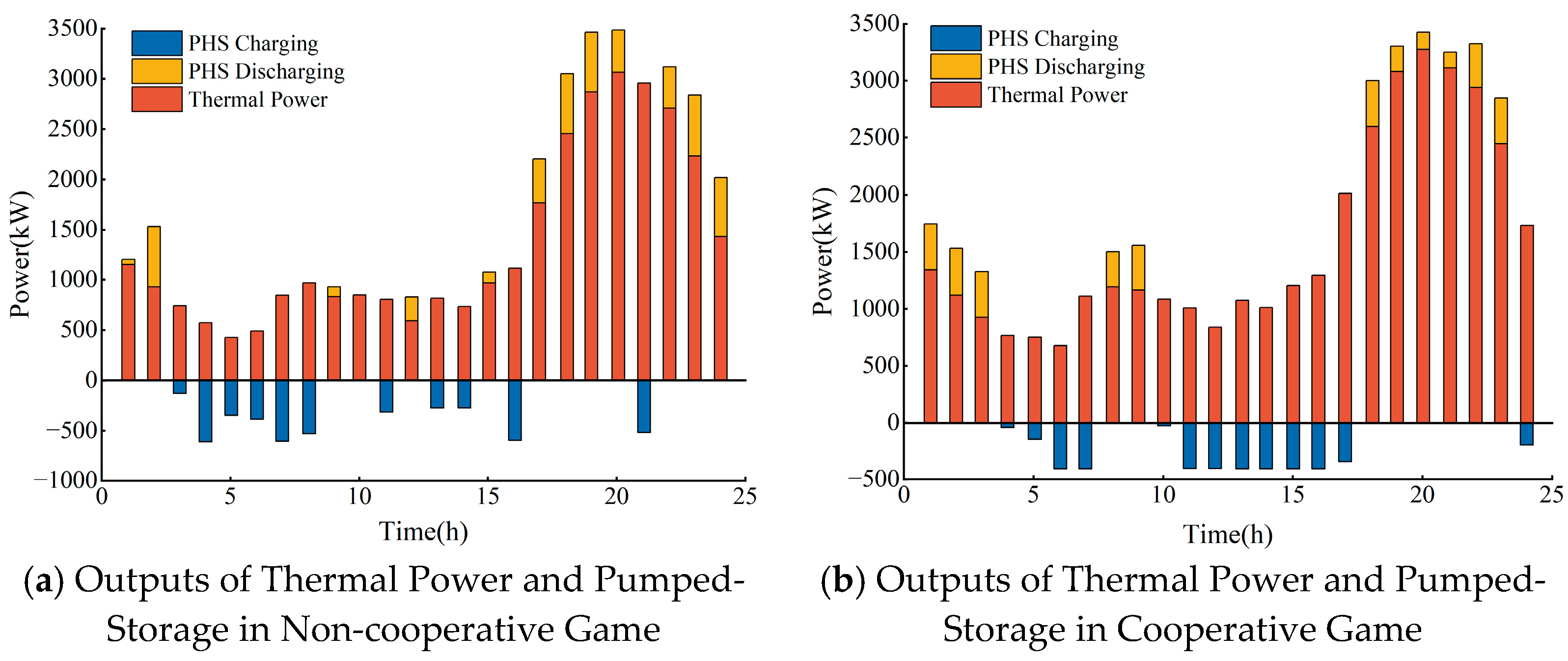
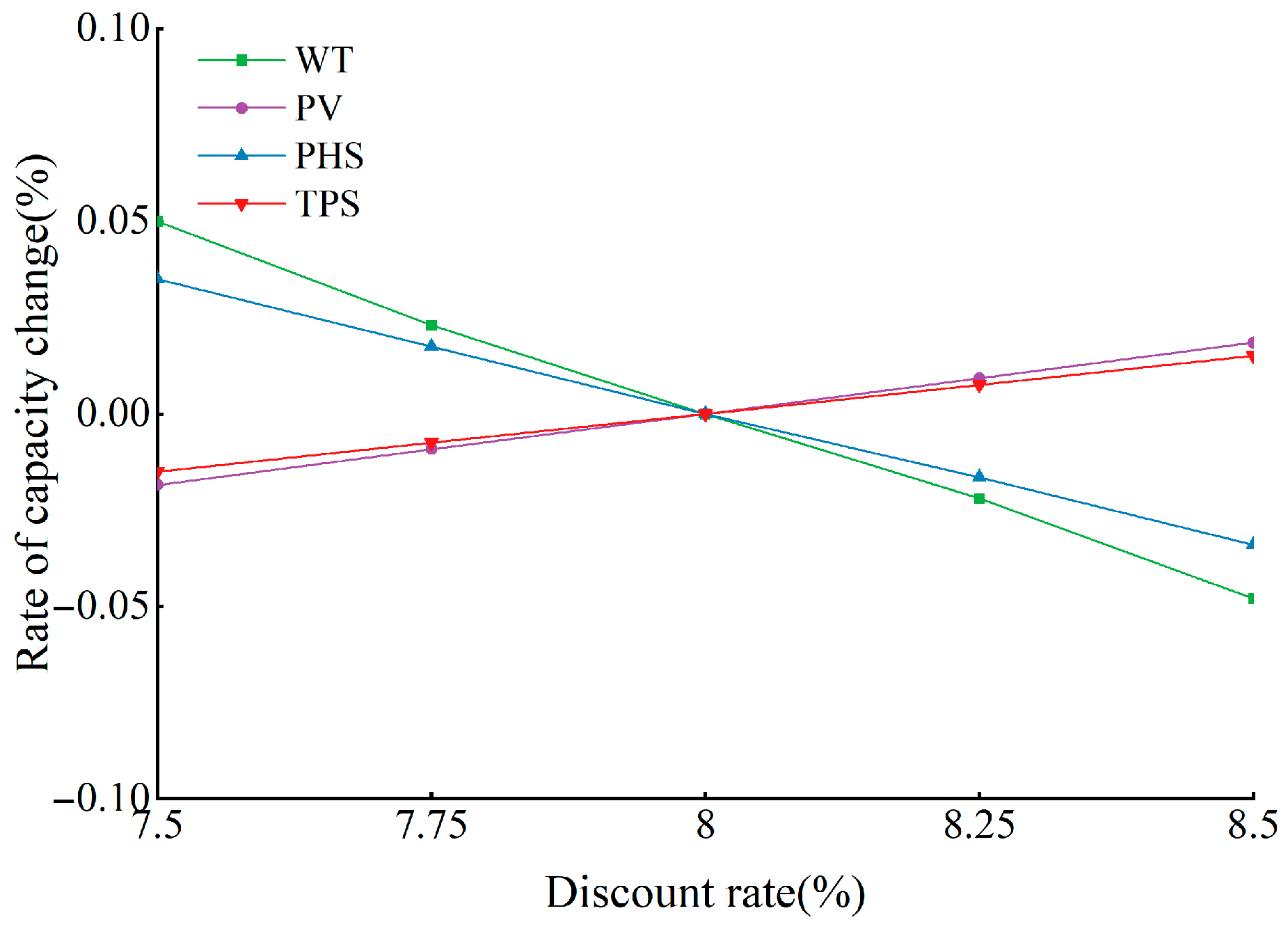
| Ref. | WT | PV | ES | TPS | Bi-Level Optimal Model | Game Theory | Uncertainties Considered |
|---|---|---|---|---|---|---|---|
| [6] | √ | √ | √ | × | × | × | × |
| [7] | × | √ | √ | × | × | × | × |
| [8] | √ | √ | × | × | √ | × | √ |
| [9] | √ | √ | √ | √ | √ | × | × |
| [10] | √ | √ | × | × | × | × | × |
| [11] | √ | √ | √ | × | × | × | × |
| [13] | √ | √ | × | × | × | √ | × |
| [15] | √ | √ | √ | × | × | √ | × |
| [16] | √ | √ | × | × | × | √ | × |
| [17] | × | √ | √ | × | √ | √ | × |
| [22] | √ | √ | √ | × | × | √ | √ |
| This paper | √ | √ | √ | √ | √ | √ | √ |
| Energy Supply Subsystem | Cost Within a Scheduling Cycle | |||||
|---|---|---|---|---|---|---|
| Wind Power Generation | √ | √ | √ | √ | ||
| Photovoltaic Generation | √ | √ | √ | √ | ||
| Pumped-Storage Power Generation | √ | √ | √ | |||
| Thermal Power Generation | √ | √ | √ | √ | √ | |
| Term | Installed Capacity Range | Unit Capacity Investment Cost (CNY/kW) | Service Life (Year) | Operation and Maintenance Cost (CNY/kW) | Charge–Discharge Efficiency |
|---|---|---|---|---|---|
| Wind Power Generation | [90 kW, 6000 kW] | 5000 | 25 | 0.100 | |
| Photovoltaic Generation | [90 kW, 6000 kW] | 3500 | 25 | 0.100 | |
| Pumped-Storage Power Generation | [200 kW, 1200 kW] | 6700 | 50 | 0.050 | 0.85 |
| Thermal Power Generation | [2000 kW 4000 kW] | 3600 | 40 | 0.050 |
| Scenario | Probability |
|---|---|
| Scenario 1 | 0.3135 |
| Scenario 2 | 0.2179 |
| Scenario 3 | 0.2653 |
| Scenario 4 | 0.2033 |
| Scenario Set | Term | Expected Revenue (104 CNY) | Installed Capacity (kW) | Renewable Energy Utilization Rate (%) | Times (s) |
|---|---|---|---|---|---|
| Reduced scenario set | Wind Power Generation | 1005.83 | 2700 | 94.66 | 56.32 |
| Photovoltaic Generation | 656.70 | 3000 | 91.77 | ||
| Pumped-Storage Power Generation | 173.84 | 600 | |||
| Thermal Power Generation | 1808.45 | 4000 | |||
| Original scenario set | Wind Power Generation | 1001.73 | 2700 | 93.52 | 201.62 |
| Photovoltaic Generation | 649.45 | 3000 | 92.32 | ||
| Pumped-Storage Power Generation | 178.35 | 600 | |||
| Thermal Power Generation | 1815.52 | 4000 |
| Algorithm | Times (s) | ||
|---|---|---|---|
| Traditional K-means algorithm | 225.13 | 0.681 | 10.54 |
| SBR algorithm | 147.62 | 2.952 | 56.32 |
| Term | Expected Revenue (104 CNY) | Revenue per Unit Capacity (104 CNY/ kW) | Siting Node | Installed Capacity (kW) | Renewable Energy Utilization Rate (%) | Total Voltage Deviation of Network Nodes (pu) | Proportion of Renewable Energy Installed Capacity (%) | Proportion of Pumped- Storage Hydropower (%) |
|---|---|---|---|---|---|---|---|---|
| Wind Power Generation | 1005.83 | 0.3725 | {24} | 2700 | 94.66 | 18.43 | 54.82 | 6.15 |
| Photovoltaic Generation | 656.70 | 0.2189 | {7} | 3000 | 91.77 | |||
| Pumped-Storage Power Generation | 173.84 | 0.2897 | {4} | 600 | ||||
| Thermal Power Generation | 1808.45 | 0.4521 | {1} | 4000 |
| Sequence Number | Alliance | Revenue Within Scheduling Period (104 CNY) | Marginal Contribution | |||
|---|---|---|---|---|---|---|
| WT | PV | PHS | TPS | |||
| 1 | {WT} | 0 | 0 | |||
| 2 | {PV} | 0 | 0 | |||
| 3 | {PHS} | 0 | 0 | |||
| 4 | {TPS} | 1678.43 | 1678.43 | |||
| 5 | {WT, PV} | 1658.85 | 1658.85 | 1658.85 | ||
| 6 | {WT, PHS} | 1533.58 | 1533.58 | 1533.58 | ||
| 7 | {WT, TPS} | 2378.39 | 699.96 | 2378.39 | ||
| 8 | {PV, PHS} | 896.57 | 896.57 | 896.57 | ||
| 9 | {PV, TPS} | 2040.11 | 361.68 | 2040.11 | ||
| 10 | {PHS, TPS} | 2109.58 | 431.15 | 2109.58 | ||
| 11 | {WT, PV, PHS} | 2180.57 | 1284.00 | 646.99 | 521.72 | |
| 12 | {WT, PV, TPS} | 3505.89 | 1465.78 | 1127.50 | 1847.04 | |
| 13 | {WT, PHS, TPS} | 3361.66 | 1252.08 | 983.27 | 1828.08 | |
| 14 | {PV, PHS, TPS} | 2599.57 | 489.99 | 559.45 | 1703.00 | |
| 15 | {WT, PV, PHS, TPS} | 4351.86 | 1752.29 | 990.20 | 845.97 | 2171.29 |
| Alliance Serial Number | 11 | 12 | 13 | 14 | 15 | |
|---|---|---|---|---|---|---|
| Alliance Composition | {WT, PV, PHS} | {WT, PV, TPS} | {WT, PHS, TPS} | {PV, PHS, TPS} | {WT, PV, PHS, TPS} | |
| Revenue within Scheduling Period (CNY 10,000) | 2180.57 | 3479.58 | 3361.66 | 2599.57 | 4037.86 | |
| Installed Capacity (kW) | WT | 5100 | 2250 | 2700 | 2250 | |
| PV | 6000 | 3100 | 3200 | 2900 | ||
| PHS | 1200 | 200 | 600 | 400 | ||
| TPS | 4000 | 4000 | 4000 | 4000 | ||
| Revenue per Unit Capacity (104 CNY/ kW) | WT | 0.1882 | 0.3622 | 0.3048 | 0.4834 | |
| PV | 0.1069 | 0.2245 | 0.1322 | 0.2371 | ||
| PHS | 0.4824 | 2.9428 | 0.5130 | 1.4508 | ||
| TPS | 0.4987 | 0.4875 | 0.4672 | 0.4991 | ||
| Wind Curtailment (kW) | 13,520.10 | 3007.63 | 105.58 | 3570.85 | 1018.92 | |
| Renewable Energy Utilization Rate (%) | 83.95 | 95.11 | 96.17 | 96.78 | 97.52 | |
| Voltage Deviation (p.u.) | 13.60 | 18.40 | 18.42 | 17.45 | 12.92 | |
| Pollutant Emissions (t) | CO2 | / | 17,143.17 | 49,425.75 | 76,962.34 | 30,195.29 |
| SO2 | / | 2.58 | 7.42 | 11.56 | 4.54 | |
| CO | / | 12.39 | 35.69 | 55.58 | 21.80 | |
| Model | Non-Cooperative Game | Cooperative Game | ||||||
|---|---|---|---|---|---|---|---|---|
| Participant | WT | PV | PHS | TPS | WT | PV | PHS | TPS |
| Installed Capacity (kW) | 2700 | 3000 | 600 | 4000 | 2250 | 2900 | 400 | 3800 |
| Revenue per Unit Capacity (104 CNY/kW) | 0.3725 | 0.2189 | 0.2897 | 0.4521 | 0.4834 | 0.2371 | 1.4508 | 0.4991 |
| CO2 Emissions (t) | 35,701.24 | 30,195.29 | ||||||
| SO2 Emissions (t) | 5.36 | 4.54 | ||||||
| CO Emissions (t) | 25.78 | 21.80 | ||||||
| Voltage Deviation (pu) | 18.43 | 12.92 | ||||||
| Thermal Power Volatility (%) | 52.65 | 62.75 | ||||||
| Renewable Energy Utilization Rate (%) | 93.6187 | 97.9521 | ||||||
| Proportion of Pumped-Storage Installed Capacity (%) | 6.19 | 4.37 | ||||||
| Ratio of Renewable Energy to Pumped-Storage | 9.5:1 | 12.875:1 | ||||||
| Average Electricity Cost (CNY/kWh) | 0.358 | 0.345 | ||||||
| Payback Period (Years) | 12.3 | 10.8 | ||||||
| Method | Traditional Bi-Level Optimization Model [9] | The Bi-Level Optimization Model Proposed in This Paper | ||||||
|---|---|---|---|---|---|---|---|---|
| Participant | WT | PV | PHS | TPS | WT | PV | PHS | TPS |
| Expected Revenue (104 CNY) | 922.83 | 624.96 | 149.52 | 1724.8 | 1087.65 | 687.59 | 580.32 | 1896.58 |
| Installed Capacity (kW) | 2850 | 3200 | 600 | 4000 | 2250 | 2900 | 400 | 3800 |
| Revenue per Unit Capacity (104 CNY/kW) | 0.3238 | 0.1953 | 0.2492 | 0.4312 | 0.4834 | 0.2371 | 1.4508 | 0.4991 |
| CO2 Emissions (t) | 39,235.30 | 30,195.29 | ||||||
| SO2 Emissions (t) | 5.89 | 4.54 | ||||||
| CO Emissions (t) | 28.78 | 21.80 | ||||||
Disclaimer/Publisher’s Note: The statements, opinions and data contained in all publications are solely those of the individual author(s) and contributor(s) and not of MDPI and/or the editor(s). MDPI and/or the editor(s) disclaim responsibility for any injury to people or property resulting from any ideas, methods, instructions or products referred to in the content. |
© 2025 by the authors. Licensee MDPI, Basel, Switzerland. This article is an open access article distributed under the terms and conditions of the Creative Commons Attribution (CC BY) license (https://creativecommons.org/licenses/by/4.0/).
Share and Cite
Chen, Z.; Huang, Y.; Dong, Y.; Ni, Z. Game Theory-Based Bi-Level Capacity Allocation Strategy for Multi-Agent Combined Power Generation Systems. Energies 2025, 18, 5338. https://doi.org/10.3390/en18205338
Chen Z, Huang Y, Dong Y, Ni Z. Game Theory-Based Bi-Level Capacity Allocation Strategy for Multi-Agent Combined Power Generation Systems. Energies. 2025; 18(20):5338. https://doi.org/10.3390/en18205338
Chicago/Turabian StyleChen, Zhiding, Yang Huang, Yi Dong, and Ziyue Ni. 2025. "Game Theory-Based Bi-Level Capacity Allocation Strategy for Multi-Agent Combined Power Generation Systems" Energies 18, no. 20: 5338. https://doi.org/10.3390/en18205338
APA StyleChen, Z., Huang, Y., Dong, Y., & Ni, Z. (2025). Game Theory-Based Bi-Level Capacity Allocation Strategy for Multi-Agent Combined Power Generation Systems. Energies, 18(20), 5338. https://doi.org/10.3390/en18205338





